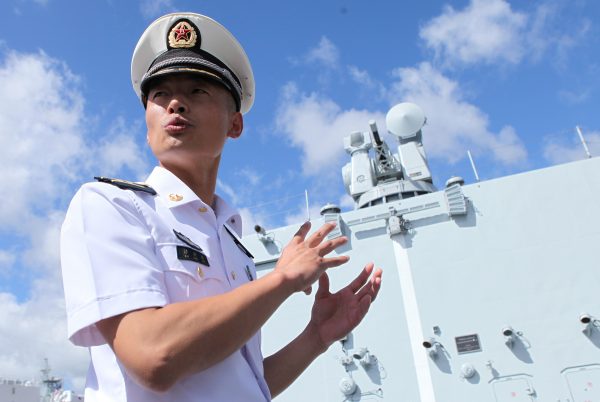CUES is a non-binding agreement that provides safety procedures as well as basic communication and manoeuvring instructions for naval ships and aircraft to follow during unplanned encounters at sea. It started out as the Code for Unalerted Encounters at Sea, which was initially presented at a Western Pacific Naval Symposium (WPNS) workshop in 1998 and later endorsed by the symposium’s naval chiefs.
The original code did not gain wide acceptance. Attempts to revitalise it in 2014 were initially blocked by China, apparently because it was called a ‘code’ — which could be interpreted as binding — and because it used English as the primary language of communication. But in April 2014 the renamed CUES was adopted by all 21 WPNS member states, including China and all ASEAN claimant states in the South China Sea. Both the US and Chinese navies now routinely use CUES and in late 2015 China proposed joint training with ASEAN on its use.
The adoption of CUES at the recent China–ASEAN Leaders’ Meeting is more a political gesture than a meaningful measure to reduce the risks of an incident in the South China Sea. It only extended CUES to two additional countries — landlocked Laos which does not have a navy and Myanmar whose navy does not operate in the South China Sea.
Currently CUES only applies to navies but there have been frequent calls for it to be extended to coast guards. During a visit to China in early 2016, Singapore’s Foreign Minister Vivian Balakrishnan suggested to the Chinese that CUES should be expanded to cover both naval vessels and coast guards.
The Philippines has also proposed the inclusion of coast guards and other maritime forces in CUES. This proposal was made at the 2016 ASEAN Defence Ministers Meeting (ADMM) in Laos. But there was little hope that the proposal would be positively considered, as the ADMM’s purview does not extend to civilian coast guards. The United States has also expressed interest in expanding CUES to the US and Chinese coast guards.
This desire to expand CUES to coast guards largely stems from the fact that the vast majority of incidents in the South China Sea involve coast guard and other law enforcement vessels. Of the 45 major incidents identified in the South China Sea between 2010 and 2016, at least one Chinese coast guard or other Chinese maritime law enforcement vessel was involved in 71 per cent of incidents.
Regional coast guards have somewhat justifiably tended to oppose the extension of CUES to their operations. Their functions and responsibilities are distinct from those of navies and they have different approaches to the use of force. A basic clash exists between the military ethos of applying maximum force and that of civil law enforcement, which is normally more circumspect and involves minimum force.
Coast guards might use force as part of their day-to-day enforcement duties, but some of their tactics are listed as ones to be avoided under CUES — such as the simulation of attacks and the discharge of weapons. But routine actions by coast guard vessels in their law enforcement role could include the use of water cannons, shouldering and firing warning shots.
Coast guard ships may also encounter each other under different circumstances. They may want to close in on each other whereas warships meeting in unplanned circumstances will normally keep clear of each other. While most of the safety procedures set out in CUES are relevant to coast guards, they may be less comfortable with some of the detailed communications procedures and manoeuvring instructions in the annexes to CUES. These are very ‘naval’ and arguably not relevant to or easily understood by coast guards.
Multilateral cooperation can also be more challenging between coast guards than between navies. Navies have clear functions and a long history of cooperation. But the role of coast guards can vary significantly from one country to another.
None of this is to say that coast guards don’t need a CUES-type document to prevent and manage the risks of incidents involving civil law enforcement vessels. But its focus should instead be on safety and common understandings with maritime law enforcement.
Sam Bateman is an adviser to the Maritime Security Programme at the S. Rajaratnam School of International Studies (RSIS), Nanyang Technological University.


Firstly, how would you define ‘progress’ in some future imaginary event, in this case “…made some progress in preventing a future disaster in the South China Sea..” as you put it? It would seem to me that the statement itself is contradictory as you evidently believe that a future event can be prevented though it can not be established whether it will or will not occur. This seems to be rather absurd. It is equally absurd to suggest that mere agreement equates to progress.